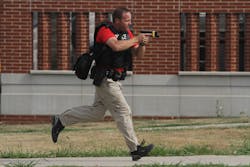Active Shooter or Hostage Barricade Situation?
For the past three to four months—as this is published—there has been a great deal of conversation about the police response to the Uvalde school shooting. While the mainstream media has been hyper-critical of every police action taken, true law enforcement tactics experts have offered observations about what could have been different and better.
The largest criticism from any quarter has been about the officers waiting outside a classroom door and not making immediate entry; a lack of action that is believed by many to have permitted the killer to act at his leisure; a lack of action that’s been seen as unnecessarily risking the lives of the children in that classroom. Additionally, the suspect was observed outside the school prior to the attack, and many have been critical that any officer who saw him didn’t immediately engage him to prevent the attack.Let me be clear: this author was not on the scene. This author has no firsthand knowledge of the circumstances, officer observations, officer perceptions, etc. An investigation of every minute detail—in fact several of them probably—will be completed in time. Even such an investigation cannot properly document what the involved officers perceived and how they interpreted what they saw/ heard. For the purposes of this article, we’re going to focus on contemporary best practices, tactics and another active killer event that happened in 2006, the Nickel Mines school attack. Let’s briefly review the two events
Nickel Mines, Pennsylvania, Oct. 2, 2006: Charles Carl Roberts IV took hostages in a one-room Amish schoolhouse, eventually shooting 10 of them, killing five. It’s estimated that he entered the school at about 10:30 a.m. and ordered the 15 boys in the class along with several women who had infants to leave the school. The first emergency call was made to 911 at approximately 10:35 a.m. that morning and police were dispatched. The first officer reportedly arrived six minutes later at 10:41 a.m. It’s important to note that what he found on his arrival was a hostage barricade situation. No shots were being fired. No one was being killed at the time of his arrival. More officers responded and communications were established with Roberts inside the school. Roberts tied up the hostages and barricaded the doors. At approximately 11 a.m., Roberts told a 911 dispatcher to have all police immediately leave the property and surrounding area or he would kill his hostages. The dispatcher tried to hold onto the conversation and buy time, but Roberts disconnected the call and shot his 10 hostages. Within seconds of the first shots, police stormed the building and Roberts committed suicide as the police made entry. It’s been observed that the only way to have prevented the shooting of the hostages is if a precision marksman had been able to shoot Roberts from a distance, through some small observable area, immediately disabling Roberts and not harming any of the hostages with the shot(s). Historically speaking, police “snipers” don’t engage hostage takers unless there is an immediate and demonstrated threat to the lives of the hostages. A threat hasn’t been met with lethal force
Uvalde, Texas, May 24, 2022: Suspect 18-year-old Salvador Ramos allegedly attacked Robb Elementary School after having attacked his grandmother at her home and taking her truck. At the school he fired shots outside before making entry, then shutting himself inside two adjoining classrooms. Reportedly, Ramos fired over 100 shots in under four minutes inside the classrooms, starting at approximately 11:33 a.m. At 11:37 a.m. he engaged officers in the hallway, injuring two. At 11:41 a.m. one Uvalde police officer reportedly said, “…there’s still shooting,” apparently meaning inside the classroom and notably eight minutes after the attack started inside the school. However, it’s worth noting that there is no report of shooting after that time until 12:21 p.m. when shots are heard (per the surveillance footage). Repeated calls are made by students to 911 asking them to send in the police immediately. At 12:50 p.m., off-duty Border Patrol officers make entry into the classroom. Ramos reportedly was hiding in a closet but exited quickly upon entry of the officers and fired at them. The officers returned fire and neutralized Ramos. The important thing to note here: No shots fired between 11:41 a.m. and 12:21 p.m.—a span of 40 minutes—and no shots fired/ heard between 12:21 p.m. and 12:50 p.m. when the room was breached (a span of 29 minutes).
Now let’s step back to the year 2000 when today’s active shooter response protocols were developed, began to evolve and were trained at least annually by most agencies. After the attack at Columbine High School in Colorado came the realization that we had to change how we responded to immediate and on-going threats. Originally the four-man diamond response was developed but that soon evolved into buddy-team responses and then single officer response. Everyone agrees that the foremost concern in any on-going attack scenario is the time efficient neutralization of the threat. That said, another protocol that has been taught throughout that time frame (since 2000) is how an active shooter event can transition into a hostage barricade situation and that officers have to be alert for that and transition to the proper tactics on demand—or as the circumstances change to demand such. The difference to remember is that response to active shooter is immediate, aggressive and ends with suspect neutralization/arrest. The response to a hostage barricade situation is creating a secure perimeter and holding it while SWAT/Tactical teams plan and execute a solution in conjunction with hostage negotiators.
IN THE MOMENT, with adrenaline running over the top, risk and threat high but rated individually based on the perception of circumstances by each officer, it can be difficult to slow down or stop short to transition from active shooter response to hostage barricade response protocols. Unfortunately, the actions of a shooter change in milliseconds and our responses simply can’t be as fast; no human’s can. Recognize that the transition from a perceived hostage barricade situation BACK to an active shooter situation happens, literally, with the sound of a gunshot. But if it’s only one… or 2, 3, 4… it’s still potentially a matter of one or two seconds. If the officers aren’t moving within that one to two second window, and then the shots stop, is it active shooter? Or hostage barricade? Many hostage barricade situations have happened wherein shots were fired but the situation stayed stable and was ended peacefully
Considering all of that, we also have to add on this huge caveat: law enforcement professionals aren’t legally (or morally) allowed to shoot a person who doesn’t present an immediate threat. We don’t do pre-emptive executions—or post action executions. Our job is to stop the on-going immediate threat to life. If such doesn’t exist we can’t use lethal force. Given the current societal optics being viewed of the Uvalde shooting incident, it seems that’s what is being demanded—stop the shooters before they become shooters. Read their mind. Read their heart. Read their intent. We need to control that message in reply: We can’t use lethal force in response to what we think a suspect might do. For us to act with lethal force we have to be preventing an immediate threat and there is a slew of conditions surrounding that use that we have to be able to articulate clearly after the fact
Be clear in your communications to the community you serve and make sure they understand what your officers can and can’t do and why. We have to fight the louder message that we aren’t killing fast enough—and that’s what seems to be the loudest voice out there.

Lt. Frank Borelli (ret), Editorial Director | Editorial Director
Lt. Frank Borelli is the Editorial Director for the Officer Media Group. Frank brings 20+ years of writing and editing experience in addition to 40 years of law enforcement operations, administration and training experience to the team.
Frank has had numerous books published which are available on Amazon.com, BarnesAndNoble.com, and other major retail outlets.
If you have any comments or questions, you can contact him via email at [email protected].





